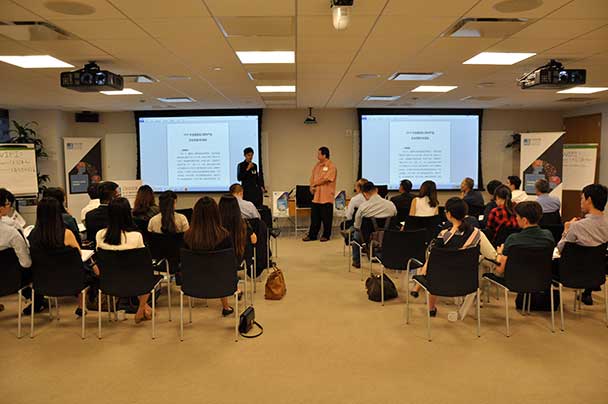Venture investor Li Yong, the lead speaker at a CKGSB Knowledge Series presentation on Chinese foreign investment, says the country’s urbanization initiatives will keep consumer spending growing and push China’s economy to become the world’s largest, despite economic headwinds.
Venture investor Li Yong, the lead speaker at a CKGSB Knowledge Series presentation on Chinese foreign investment, says the country’s urbanization initiatives will keep consumer spending growing and push China’s economy to become the world’s largest, despite economic headwinds.

“Urbanization in China is so strong that consumer spending, no matter what happens to the economy, the real estate market or even the stock market, is going to continue to grow,” Mr. Yong, Partner at IW Ventures, said during the August 25 session, “The New Dynamics of China’s Investment Abroad”. In addition to Mr. Yong, whose New York-based firm specializes in China-related investments, the event held at CKGSB’s New York office showcased the views of Wang Jinlong (Jerry), Founder and CEO of Haitou, China’s first overseas investment platform, and Huang Xiaofeng, President of BJX, a New York-based firm focused on agriculture-related cross-border investment.
Before becoming a partner at IW Ventures, Mr. Yong worked at several banks, including Lehman Brothers, and with a top-ranked fixed income hedge fund in New York.
His talk contrasted development plans for two “Tier 3” cities – Omaha, Nebraska, headquarters of billionaire investor Warren Buffett’s Berkshire Hathaway conglomerate, and Yibin, a prefecture-level city in the southeastern part of China’s Sichuan province, located at the junction of the Min and Yangtze Rivers.
Infrastructure investment
Although Yibin’s urban area is smaller than Omaha’s, long-term Chinese governmental infrastructure investment is setting the stage for an expansion of the city’s urban area, propelling a dramatic population increase, Mr. Yong said. In 15 years, the addition of highways, a high-speed train, an industrial complex and other improvements is expected to boost Yibin’s population to more than 2 million, or as much as 3 million if more people continue to move to the expanding urban area, he said. By contrast, Omaha’s population, constrained by its official borders, is expected to swell to just 1 million.
An expected rise in consumer spending in Yibin is expected to cause Starbucks coffee houses, symbols of consumption, to start popping up in the city, Mr. Yong said. There are currently no Starbucks outlets in Yibin, he said. By contrast, Omaha has several.
As an increasingly wealthy Chinese population is experiencing a growing appetite for well-respected US brands, “wealth distribution in terms of their investments will increase overseas in relation to dollar-based assets,” Mr. Yong said. Consumption will boost the GDP, inevitably driving China to overtake the US as the world’s largest economy within 15 or 20 years, he said.
US economic growth in recent years has been slow but stable, expanding at an annual rate of 2.0 to 2.5 percent. In comparison, China’s GDP was 6.9 percent in 2015. The government has set a GDP goal of 6.5 percent for this year.
The session stemmed from the rapid growth in China’s overseas investment, reaching more than $120 billion in 2014. China will become one of the world’s biggest cross-border investors by the end of this decade, with global offshore assets tripling from $6.4 trillion now to nearly $20 trillion by 2020, according to research.
While much of the total will be in the form of foreign exchange reserves and portfolio investment, a growing share will come from direct Chinese investment in developed western countries, according to a joint report by the economic research firm Rhodium Group and the Berlin-based Mercator Institute for China Studies.
Panelist Wang of Haitou in his remarks noted that his clients put money into the US because of a perception that the country is “one of the biggest and one of the most stable markets.”
China investors, hamstrung by limited investment vehicles for their money at home, are investing in diverse fields, including platforms such as ride sharing service Uber, photo-sharing site Pinterest and data marketing firm Palantr, said Mr. Wang, whose firm helps Chinese investors allocate capital in the US.
Shuanghui-Smithfield
Mr. Huang’s segment focused on US pork exports to China. He cited a watershed event in US-China relations, Shuanghui International Holdings’ 2013 acquisition of US pork producer Smithfield Foods Inc. for $4.7 billion, as an example of a deal that was driven by growing pork demand in China as its increasingly wealthy citizens consume more protein.
The Smithfield deal has led to more transactions aimed at helping China obtain raw materials and technology needed to run the nation’s growing economy. At the time, it was China’s largest cross-border deal since CNOOC Ltd paid $15.1 billion for Canadian oil and gas producer Nexen Ltd.
“The Smithfield deal has been very successful in the business so now other similar American companies and Chinese companies are looking for each other,” Mr. Huang said through Mr. Wang, who acted as an interpreter. “But they haven’t been in touch with each other yet. So we think this is the right time to build a bridge to let the US side and the Chinese side set up a connection.”